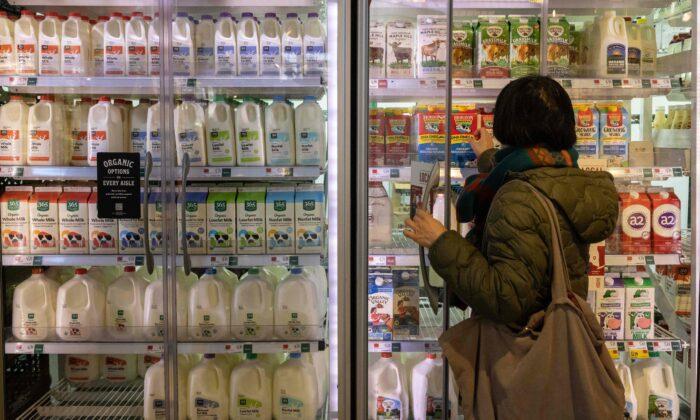On a month-over-month basis, the consumer price index (CPI) rose just 0.1 percent, down from 0.4 percent and below the market estimate of 0.2 percent.
“Today’s report is good news for hard working families. It shows continued progress tackling inflation at the same time that unemployment remains at historic lows,” President Joe Biden said in a statement. “I’ve never been more optimistic that our best days are ahead of us.”
The picture was less rosy, however, when excluding food and energy prices.
The core CPI, which excludes the volatile prices of food and energy, was at 5.3 percent year-over-year, down from 5.5 percent in the previous month. This also matched economists’ expectations. Core inflation climbed 0.4 percent on a monthly basis, unchanged from the previous month. The monthly core CPI has risen 0.4 percent or more for six consecutive months.
Core inflation remains high, partly because of persistent rise in house and rental costs. The shelter index rose 0.6 percent month-over-month and advanced 8 percent in the 12 months ending in May.
The big decline in energy costs, however, slowed the overall inflation increase last month.
The energy index declined 11.7 percent year-over-year and 3.6 percent from April to May. Gasoline dropped 5.6 percent month-over-month, and fuel oil plunged 7.7 percent on a monthly basis. Electricity costs slipped 1 percent in May.
Food prices, however, were up 6.7 percent on an annualized basis, with supermarket prices easing to 5.8 percent. Food away from home remained above 8 percent.
Within the food index, the most notable development was the crash in egg prices, plummeting 13.8 percent month-over-month. Eggs are now down 0.4 percent year-over-year.
Meat prices dropped more than 1 percent in May, but beef and veal are beginning to trend higher, as a chorus of food economists had warned. The beef and veal category jumped 1 percent, uncooked ground beef surged 2 percent, and uncooked beef roasts rose 1.2 percent.
Among the kitchen staples, bread prices remain 12.5 percent higher than a year ago, flour is up more than 17 percent and rice swelled 7.1 percent on an annualized basis.
Fruits and vegetables increase at a significant pace on a monthly pace, rising 1.4 percent. This included a 1.9 percent spike in apples and a 5.3 percent jump in lettuce.
Margarine remained elevated, soaring 22.5 percent year-over-year and 2.1 percent month-over-month.
Baby food and formula were 10.1 percent more expensive than in the same period a year ago and surged 1.2 percent month-over-month.
New vehicles dipped 0.1 percent month-over-month, while used cars and trucks surged 4.4 percent for the second consecutive month. Airline fares, meanwhile, fell by 3 percent in May and 13.4 percent year over year.
While consumer price inflation slowed sharply in May driven by a 5.6 percent drop in gasoline prices, some major categories continued to see notable increases, according to Scott Anderson, chief economist of Bank of the West.
“In short, the continued moderation in consumer prices in May should allow the Fed to skip another rate hike at the conclusion of its meeting tomorrow,” Anderson wrote in a note.
However, he noted that the Fed officials would continue to be data dependent and may raise “the fed funds rate at the conclusion of their July meeting if the economic and core inflation data continue to come in stronger than expected.”

The next key inflation metric will be producer prices. The May producer price index (PPI) is forecast to ease to 1.5 percent year-over-year and tumble 0.1 percent month-over-month. The core PPI is also anticipated to slow to 2.9 percent and rise 0.2 percent month-over-month.
In pre-market trading, the financial markets recorded tepid gains following the CPI data.
The U.S. Treasury market was red across the board, with the benchmark 10-year yield down nearly 8 basis points to below 3.69 percent. The 1-month bill shed more than 2 basis points to around 5.16 percent.
FOMC Expectations
For many market observers, the May CPI figures were crucial for what the Federal Reserve does at the end of its two-day Federal Open Market Committee (FOMC) policy meeting this week.But even if the FOMC chooses a rate pause, some officials argue that this might not signal the end of its quantitative tightening campaign. Some have alluded to the recent decisions by the Bank of Canada (BoC) and the Reserve Bank of Australia (RBA).
After an unexpected increase in inflation, the BoC raised interest rates by 25 basis points this month following a two-meeting pause. The RBA left its policy rate unchanged in April and then pulled the trigger on two straight rate hikes.
Whatever happens at the June FOMC meeting, some economists purport that this is not the end of the hiking cycle.
The futures market is also pricing in a quarter-point hike in July.





